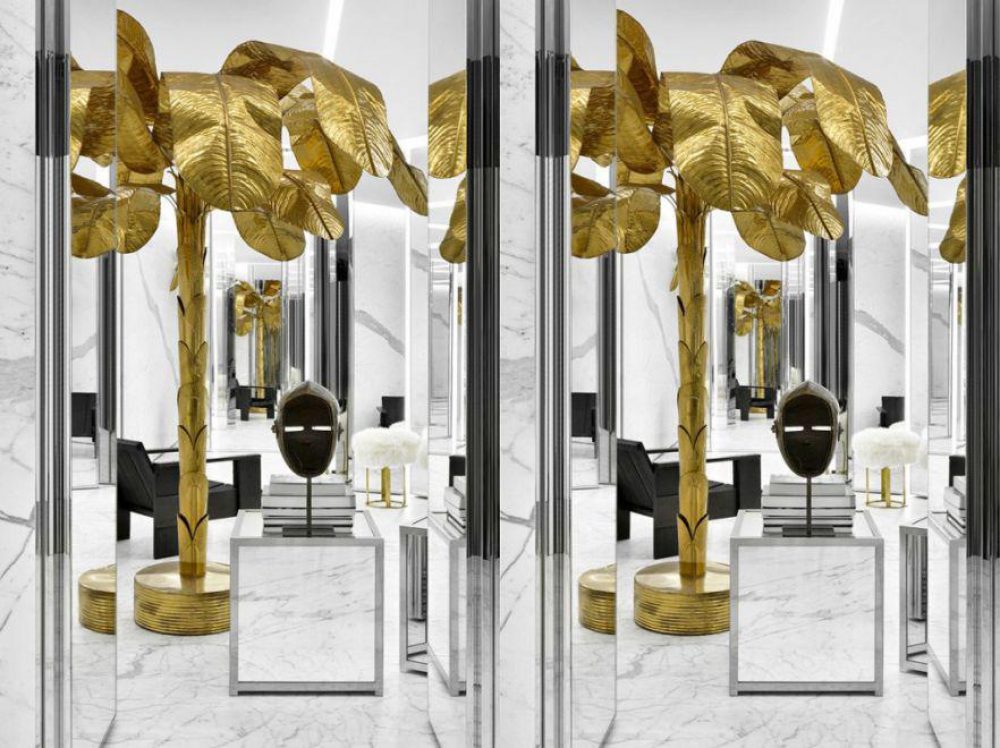Editor’s Note: “Queer Tropics”
Charlie Tatum, our Editorial and Communications Manager, introduces Pelican Bomb’s latest exhibition and a corresponding series on the Art Review, which both explore conceptions of the tropics.

Saint Laurent’s Omotesando store in Tokyo.
When I moved to New Orleans nearly three and a half years ago, I remember thinking that I never wanted to live anywhere without palm trees again. Partly this was a reaction to seven long New York winters, but it was also a vibe. Who wouldn’t want to feel like they’re on permanent vacation? By 2014, a resurgence of tropical-print motifs had already begun to take over fashion, interior design, and the art world—retooling a long-standing fascination with beach culture for the aspirational age of Instagram. “Queer Tropics,” our current exhibition at Pelican Bomb Gallery X, aims to pick apart this fascination, presenting works by eight artists approaching conceptions of the tropics from different perspectives and locations, with a particular focus on sexuality and the body—whether Joiri Minaya’s critique of the fetishization of the Caribbean and Latin America, Madeline Gallucci’s formal exploration of colorful tourist kitsch, or Carlos Motta’s historical look at early colonial encounters in the Americas.
While working on the exhibition, I began to reflect on the distinction between appearance and reality, between the image of a place presented to a tourist and the very facts of life for residents. In 2015, nearly ten million visitors traveled to New Orleans, in contrast to a resident population of less than 400,000. The large number of short-term rentals across the city—particularly in neighborhoods like the Marigny, where ten percent of residences are listed through AirBNB—create the impression that tourists can experience the “real New Orleans,” but they don’t grapple with the difficult parts of daily life here: a failing education system, crumbling infrastructure, soaring crime rates, and the effects of mass incarceration. Similarly, the stop-and-go model of cruise lines presents port cities and islands as picture-perfect places one can visit without any sense of responsibility, accountability, or engagement, leaving environmental and economic destruction in their wake. Several of the artists in “Queer Tropics” examine the detrimental effects of this disjointedness. One example is Minaya’s large-scale photograph Container #1, 2015, which depicts the Dominican-American artist bound in a leaf-print fabric sack, smothered by erotic expectation.
But through this exhibition, we don’t aim to simplify the conversation by writing off all imagining of the tropics as detrimental, restrictive, and colonialist. Artists are also often looking at the tropics as a space of self-identification in its own right and against hegemonic values. If the popularity of the tropics is linked to its status as a site of otherness—a place outside the strictures of Euro-American daily life—then it can also challenge the attendant normative understandings of race, gender, and sexuality. In her room-sized installation, Adrienne Elise Tarver finds power in considering the tropics a landscape that mythically and historically connects the African diaspora and feminine energy. With a plexiglass photo-sculpture and a screen print, Pacifico Silano looks back at a lineage of gay male sociality in beachside locales like Fire Island Pines, Provincetown, Jacob Riis Park, and Miami’s South Beach that have provided public and celebratory spaces for queer communities.
Throughout the next two months, we’re using the Art Review to look at the ways artists have complicated—and continue to complicate—simplistic understandings of the tropics and to examine how sexuality and fantasy factor into historical and contemporary relationships between the United States, Europe, and the Global South. We’ll be publishing features on artists and cultural figures like Radamés “Juni” Figueroa, Minnette de Silva, and Hélio Oiticica; an essay on New Orleans’ own red-light district, Storyville; and an exploration of landscape photography and cruising online—in addition to other topics. Our hope is, as always, to provide a springboard for considering more closely our own positions in the world, whether in New Orleans, the so-called “northernmost city in the Caribbean,” or elsewhere.



